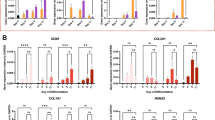Abstract
Periosteum-derived progenitor cells (PDPCs) could be differentiated into cartilage using atelocollagen as a carrier and in the presence of transforming growth factor-β3 (TGF-β3). Chondrogenesis was verified by RT-PCR and Western blotting. Expression of the type II collagen mRNA was found from the differentiated PDPCs in atelocollagen 3 weeks after chondrogenic induction. The chondrogenic potential of the PDPCs was also verified by histochemical staining for type II collagen protein. Increased production of glycosaminoglycan shows that the PDPCs in atelocollagen could differentiate into chondrocytes under a chondrogenic environment. PDPCs can therefore be used as a cell source for cell-based therapies targeted toward the articular cartilage of the knee.





Similar content being viewed by others
References
Brittberg M, Lindahl A, Nilsson A, Ohlsson C, Isaksson O, Peterson L (1994) Treatment of deep cartilage defects in the knee with autologous chondrocyte transplantation. N Engl J Med 331:889–895
de Bari C, Dell’Accio F, Tylzanowski P, Luyten FP (2001a) Multipotent mesenchymal stem cells from adult human synovial membrane. Arthritis Rheum 44:1928–1942
de Bari C, Dell’Accio F, Luyten FP (2001b) Human periosteum-derived cells maintain phenotypic stability and chondrogenic potential throughout expansion regardless of donor age. Arthritis Rheum 44:85–95
Fickert S, Fiedler J, Brenner RE (2003) Identification, quantification and isolation of mesenchymal progenitor cells from osteoarthritic synovium by fluorescence automated cell sorting. Osteoarthr Cartilage 11:790–800
Ito Y, Fitzsimmons JS, Sanyal A, Mello MA, Mukherjee N, O’Driscoll SW (2001) Localization of chondrocyte precursors in periosteum. Osteoarthr Cartilage 9:215–223
Iwasa J, Ochi M, Uchio Y, Katsube K, Adachi N, Kawasaki K (2003) Effects of cell density on proliferation and matrix synthesis of chondrocytes embedded in atelocollagen gel. Artif Organs 27:249–255
Lim SM, Choi YS, Shin HC, Lee CW, Kim DI (2005) Isolation of human periosteum-derived progenitor cells using immunophenotypes for chondrogenesis. Biotechnol Lett 27:607–611
Lynn AK, Yannas IV, Bonfield W (2004) Antigenicity and immunogenicity of collagen. J Biomed Mater Res B Appl Biomater 71:343–354
Majumdar MK, Banks V, Peluso DP, Morris EA (2000) Isolation, characterization, and chondrogenic potential of human bone marrow-derived multipotential stromal cells. J Cell Physiol 185:98–106
Murata M, Maki F, Sato D, Shibata T, Arisue M (2000) Bone augmentation by onlay implant using recombinant human BMP-2 and collagen on adult rat skull without periosteum. Clin Oral Implants Res 11:289–295
Ochi M, Uchio Y, Kawasaki K, Wakitani S, Iwasa J (2002) Transplantation of cartilage-like tissue made by tissue engineering in the treatment of cartilage defects of the knee. J Bone Joint Surg Br 84:571–578
Ochi M, Uchio Y, Tobita M, Kuriwaka M (2001) Current concepts in tissue engineering technique for repair of cartilage defect. Artif Organs 25:172–179
Pontz B, Meigel W, Rauterberg J, Kuhn K (1970) Localization of two species specific antigenic determinants on the peptide chains of calf skin collagen. Eur J Biochem 16:50–54
Schaefer D, Martin I, Jundt G, Seidel J, Heberer M, Grodzinsky AJ, Bergin I, Vunjak-Novakovic G, Freed LE (2002) Tissue engineered composites for the repair of large osteochondral defects. Arthritis Rheum 46:2524–2534
Uchio Y, Ochi M, Matsusaki M, Kurioka H, Katsube K (2000) Human chondrocyte proliferation and matrix synthesis cultured in Atelocollagen gel. J Biomed Mater Res 50:138–143
Yang EK, Seo YK, Youn HH, Lee DH, Park SN, Park JK (2000) Tissue engineered artificial skin composed of dermis and epidermis. Artif Organs 24:7–17
Acknowledgements
This work was supported by Korea Science and Engineering Foundation (KOSEF R01-2005-000-10927-0) and also by Boryung Pharmceutical Co. Ltd., Ansan, Korea
Author information
Authors and Affiliations
Corresponding author
Rights and permissions
About this article
Cite this article
Choi, YS., Lim, SM., Shin, HC. et al. Chondrogenesis of human periosteum-derived progenitor cells in atelocollagen. Biotechnol Lett 29, 323–329 (2007). https://doi.org/10.1007/s10529-006-9240-2
Received:
Revised:
Accepted:
Published:
Issue Date:
DOI: https://doi.org/10.1007/s10529-006-9240-2




